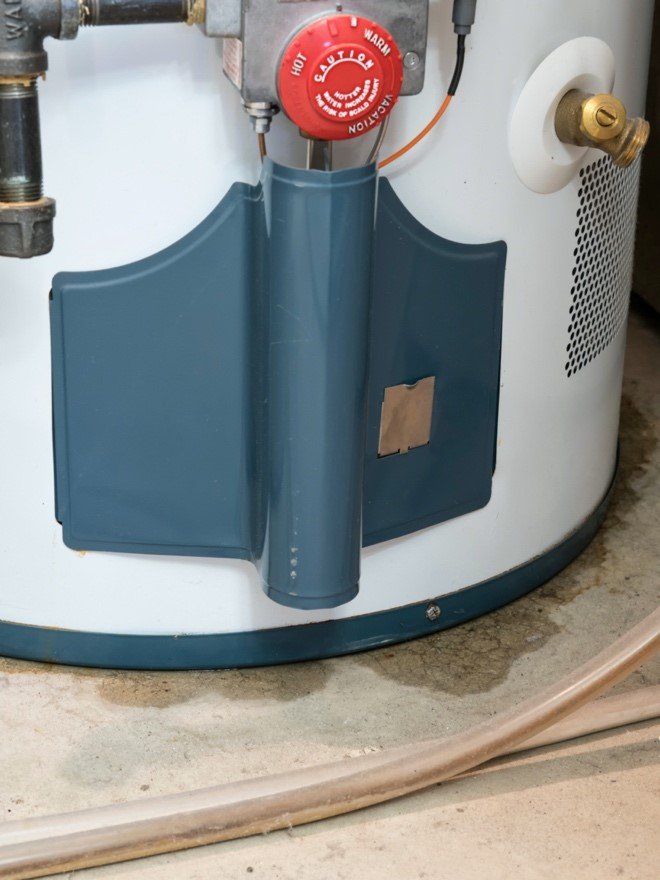Once in a while, our home inspectors come across a leaking water heater during a home inspection. What we typically find are leaks at one of three locations: at the temperature pressure relief valve, at the bottom (which may indicate corrosion within the water heater tank), or at the water heater's incoming and outgoing water lines. Regardless of the cause, it’s crucial to repair a leak as soon as possible to avoid damage to the water heater and its surroundings.
The water heater’s temperature pressure relief valve is leaking.
Why is my water heater leaking?
A modern water heater's average life expectancy is between 8 and 12 years, but we’ve seen water heaters fail in the five- to six-year range. Recently, I did an inspection, and a water heater from 1987 was still functioning properly and not leaking. Below are some points to help guide you through determining the source of a leak and potentially how to fix it.
Age and high water pressure are the most common reasons for a water heater to start leaking. Over time, mineral deposits build up in your water heater and cause tank corrosion. High water pressure can also cause valves to weaken and leak over time. Other times, internal components or water lines can fail due to age.
First, shut off all sources of energy.
Before you start working on your water heater, it is a good idea to shut off all energy sources. Turn off the water heater water supply valve, disconnect the electrical power, and turn off the gas valve. These should all be within reach of your water heater.
Most water heaters will have a valve at the supply side that you can close to shut off the water source. There should also be a gas valve close to the gas controller on your water heater. If your water heater is electric or has a forced draft blower, it will either have an electrical switch or connect directly to a wall outlet.
Do you need to drain the water heater?
If your water leak is substantial, you will want to drain your water heater to prevent further leakage or water damage. There is a drain valve at the bottom of your water heater. Hook up a garden hose and run it to a floor drain or the exterior of your home. Draining your water heater should be part of your annual maintenance program. It will allow the removal of any loose sediment at the bottom of the tank.
Determining the source of your water heater leak.
If the water heater is leaking at the bottom or if you only see water on the floor or in the drain pan below it, it may be old, and the tank may be rusted. A leaking tank means that you will need to replace your water heater.
The water heater tank is leaking onto the floor.
Check the Temperature Pressure Relief Valve (TPRV).
If your water leak is coming from the temperature pressure relief valve, there are a couple of things you can try. Occasionally, a piece of debris may get stuck in the valve and not allow it to close completely. You can open and close the valve several times to see if it seals.
Temperature Pressure Relief Valve
If the valve does not seal, you must replace the TPRV. This is a relatively simple procedure, but you may want to hire a plumber.
What if the water heater’s water supply inlet or outlet pipes are leaking?
Sometimes, the inlet and outlet water supply pipes will leak. Typically, these connections have to be redone to stop the leak. Hire a plumber if you are uncomfortable working with water lines.
Leaking inlet/outlet water lines.
Water leaking from the drain valve is a concern.
As mentioned earlier, your water heater has a drain valve. Similar to the temperature pressure relief valve, this seal can sometimes catch a small piece of debris and not seal properly. Open and close the valve several times to try to get it to seal properly. If it does not seal, you may want to replace the valve. Again, you may want to hire a plumber if you are uncomfortable doing it yourself.
Annual water heater maintenance is essential.
Drain your water heater annually. As stated before, your water heater can be drained by attaching a garden hose to the valve and routing it to a floor drain or to the exterior of your home. Draining your water heater will help flush out any sediment on the bottom of the tank and reduce the probability of corrosion.
Check your temperature pressure relief valve and discharge tube; the discharge tube attached to your temperature pressure relief valve typically terminates within 12 inches of the floor. Inspect the bottom of the tube for any water and/or leaks on the floor.
Water heater discharge tube and drain valve.
Summary
Leaks in water heaters are common and, in most cases, easy to fix. However, if you cannot fix your leaks, you may need to replace your water heater.
At HomePro Inspections, our home inspectors are trained to inspect all areas of the home. Any issues found are documented in your home inspection report and recommended for resolution by yourself or a qualified professional.
Visit our website to learn more or to schedule your home inspection in the Rochester, Owatonna, and Faribault, MN areas. You can contact us today at (507) 202-8942or by email, and you can use our convenient online “Schedule Now” feature to schedule an appointment.





